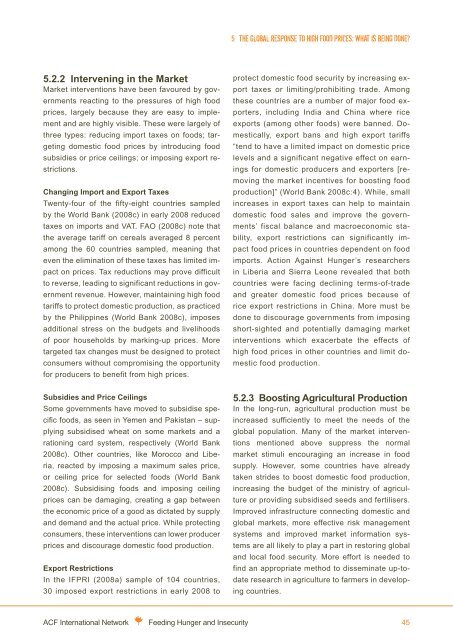Feeding hunger and insecurity
Feeding hunger and insecurity
Feeding hunger and insecurity
- No tags were found...
Create successful ePaper yourself
Turn your PDF publications into a flip-book with our unique Google optimized e-Paper software.
5. The global response to high food prices: what is being done?5.2.2 Intervening in the MarketMarket interventions have been favoured by governmentsreacting to the pressures of high foodprices, largely because they are easy to implement<strong>and</strong> are highly visible. These were largely ofthree types: reducing import taxes on foods; targetingdomestic food prices by introducing foodsubsidies or price ceilings; or imposing export restrictions.Changing Import <strong>and</strong> Export TaxesTwenty-four of the fifty-eight countries sampledby the World Bank (2008c) in early 2008 reducedtaxes on imports <strong>and</strong> VAT. FAO (2008c) note thatthe average tariff on cereals averaged 8 percentamong the 60 countries sampled, meaning thateven the elimination of these taxes has limited impacton prices. Tax reductions may prove difficultto reverse, leading to significant reductions in governmentrevenue. However, maintaining high foodtariffs to protect domestic production, as practicedby the Philippines (World Bank 2008c), imposesadditional stress on the budgets <strong>and</strong> livelihoodsof poor households by marking-up prices. Moretargeted tax changes must be designed to protectconsumers without compromising the opportunityfor producers to benefit from high prices.Subsidies <strong>and</strong> Price CeilingsSome governments have moved to subsidise specificfoods, as seen in Yemen <strong>and</strong> Pakistan – supplyingsubsidised wheat on some markets <strong>and</strong> arationing card system, respectively (World Bank2008c). Other countries, like Morocco <strong>and</strong> Liberia,reacted by imposing a maximum sales price,or ceiling price for selected foods (World Bank2008c). Subsidising foods <strong>and</strong> imposing ceilingprices can be damaging, creating a gap betweenthe economic price of a good as dictated by supply<strong>and</strong> dem<strong>and</strong> <strong>and</strong> the actual price. While protectingconsumers, these interventions can lower producerprices <strong>and</strong> discourage domestic food production.Export RestrictionsIn the IFPRI (2008a) sample of 104 countries,30 imposed export restrictions in early 2008 toprotect domestic food security by increasing exporttaxes or limiting/prohibiting trade. Amongthese countries are a number of major food exporters,including India <strong>and</strong> China where riceexports (among other foods) were banned. Domestically,export bans <strong>and</strong> high export tariffs“tend to have a limited impact on domestic pricelevels <strong>and</strong> a significant negative effect on earningsfor domestic producers <strong>and</strong> exporters [removingthe market incentives for boosting foodproduction]” (World Bank 2008c:4). While, smallincreases in export taxes can help to maintaindomestic food sales <strong>and</strong> improve the governments’fiscal balance <strong>and</strong> macroeconomic stability,export restrictions can significantly impactfood prices in countries dependent on foodimports. Action Against Hunger’s researchersin Liberia <strong>and</strong> Sierra Leone revealed that bothcountries were facing declining terms-of-trade<strong>and</strong> greater domestic food prices because ofrice export restrictions in China. More must bedone to discourage governments from imposingshort-sighted <strong>and</strong> potentially damaging marketinterventions which exacerbate the effects ofhigh food prices in other countries <strong>and</strong> limit domesticfood production.5.2.3 Boosting Agricultural ProductionIn the long-run, agricultural production must beincreased sufficiently to meet the needs of theglobal population. Many of the market interventionsmentioned above suppress the normalmarket stimuli encouraging an increase in foodsupply. However, some countries have alreadytaken strides to boost domestic food production,increasing the budget of the ministry of agricultureor providing subsidised seeds <strong>and</strong> fertilisers.Improved infrastructure connecting domestic <strong>and</strong>global markets, more effective risk managementsystems <strong>and</strong> improved market information systemsare all likely to play a part in restoring global<strong>and</strong> local food security. More effort is needed tofind an appropriate method to disseminate up-todateresearch in agriculture to farmers in developingcountries.ACF International Network <strong>Feeding</strong> Hunger <strong>and</strong> Insecurity 45

















